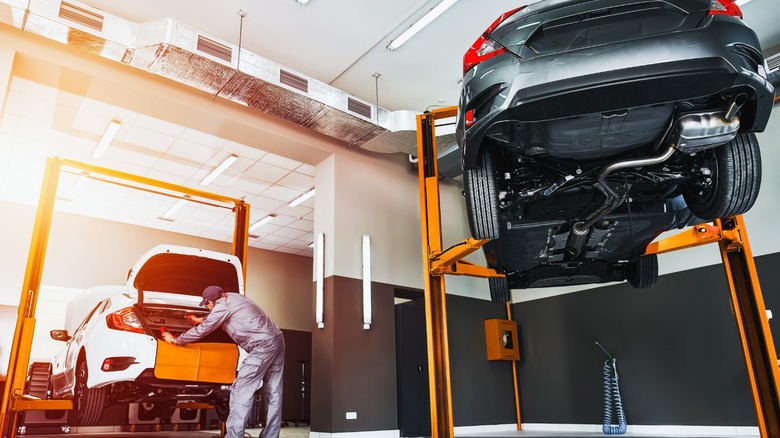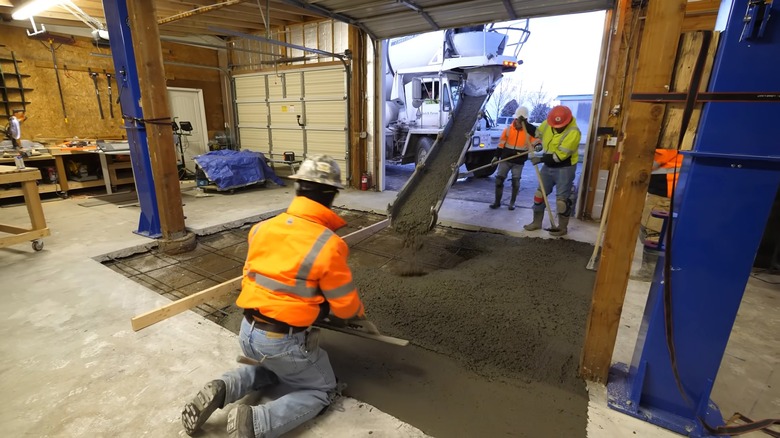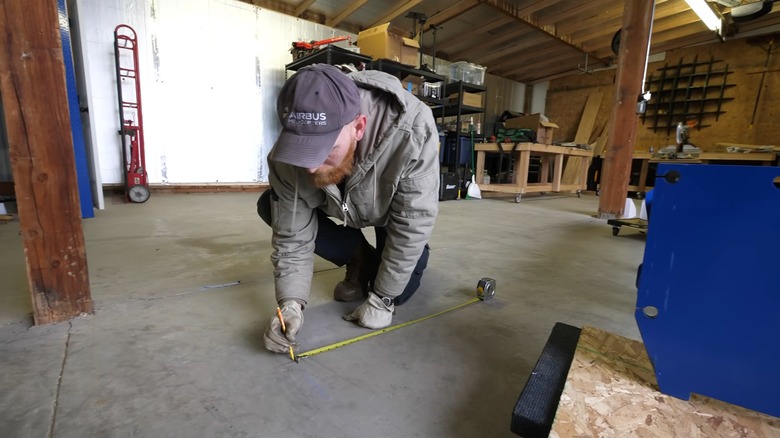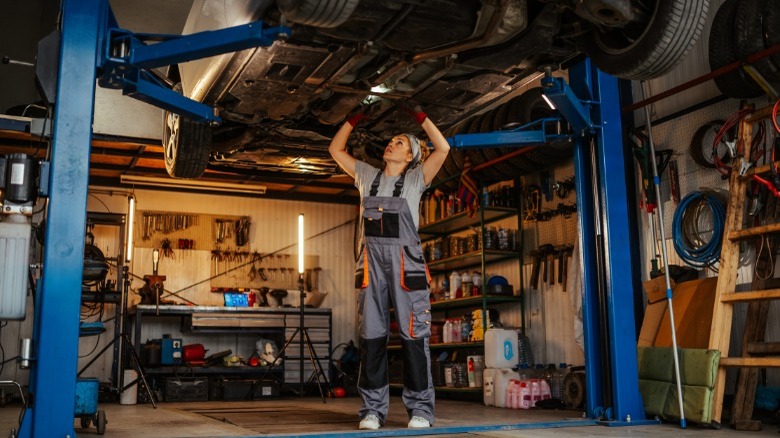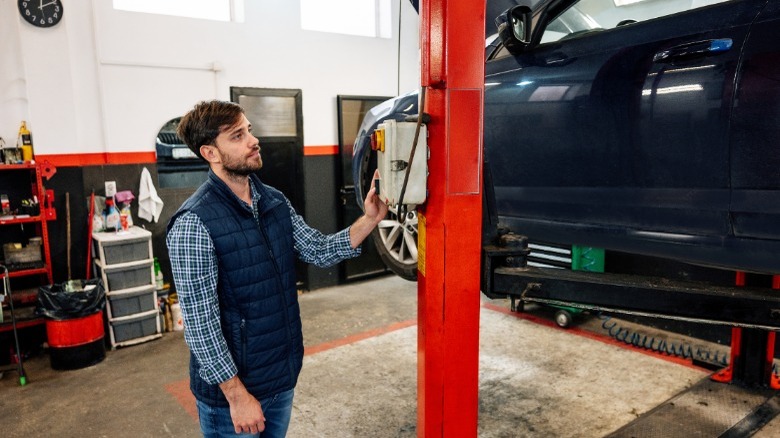Can You Put A Car Lift In Your Home Garage? (And Is It Worth It?)
If you're a home mechanic who previously worked in a professional shop, you probably don't miss much about the daily grind. Working on your own without an annoying boss and nitpicky customers can be extremely freeing — it can even reinvigorate your love of cars and turning wrenches. However, there is one thing about working in a legitimate auto repair shop that you may miss: access to a full-size professional vehicle lift.
As a former professional mechanic and lifelong tinkerer myself, I know that I've always dreamed of having my own car lift at home. Car lifts are undeniably convenient. They allow us to work underneath a vehicle while standing instead of lying on our backs on the cold hard ground. They're a common sight in professional shops, but, due to the cost and space required to install one, most home mechanics rely on different types of automotive jacks.
However, that doesn't mean it's impossible to install a car lift in your home garage. In fact, it's not only possible, but it could also be a great investment for hardcore DIYers and professional home mechanics. That said, installing a car lift can be expensive, and it does require a decent amount of real estate. Don't worry, though — we'll break it all down for you. From the cost to the required space and potential benefits, here's everything you need to know about putting a car lift in your home garage.
How much does it cost to install a car lift in your home garage?
We've already established that it is possible to install a car lift in your home garage. However, just because you can do it doesn't mean it's cheap or easy. On the contrary, installing a vehicle lift at home can be extremely pricey. On average, it costs between $1,500 and $10,000 to install a car lift in your home garage. That's a lot of money, even at the lower end, and it's due primarily to the vast amount of expensive materials and labor that goes into the installation.
Broken down, some of the expenses that contribute to the total cost of an at-home vehicle lift include things like materials, which covers everything from steel beams to electronics and hydraulic systems. Depending on the type of lift you install, the materials alone may cost upwards of $4,500. You'll also have to pay for the labor costs that come with hiring a professional company to install your lift. Not only will the installation crew have to set up the lift itself, but they may also have to do things like build floor anchors to support the lift, run hydraulic lines, program electrical equipment, and modify your garage and or garage door to accommodate the large equipment. All of that work translates to a lot of money in labor and, combined with the cost of materials, causes at-home vehicle lifts to come at a relatively steep price.
How much space do you need to install a car lift in your home garage?
Purchase and installation cost is only one of the things you need to consider before installing a car lift in your home garage. It's also critical that you consider your available space and whether it's large enough to accommodate a vehicle lift. There are various different types of car lifts, from standard two-post lifts and heavier-duty four-post lifts to in-ground and drive-over lifts. Each type of lift has its own unique applications, and each requires a different amount of space.
For a standard two-post lift capable of hoisting around 8,000 pounds, you'll need a space roughly 12-feet tall and 11-feet wide. You'll also need to ensure that your garage is long enough to accommodate the types of vehicles you plan to lift — for the average car, that's about 15 feet, while pickup trucks can measure up to around 22-feet long. Some two-post lifts may require a bit more or a bit less space, but those numbers are solid general estimates to keep in mind.
If you want to install a larger four-post lift, you may need a bit more space. However, it depends on the kinds of vehicles you plan to work on with your lift. Your height requirement may remain the same if you only want a four-post lift for storing smaller cars for extended periods or for working on larger pickup trucks and SUVs. If you plan to work on large commercial vehicles, though, you'll likely need more height. The same holds true for length and width, and especially for length, as an extra set of posts can eat into your workspace. Finally, in-ground and drive-over lifts generally require less space, but may not be able to support as much weight or lift as high off the ground.
What are the different types of car lifts?
As mentioned, there are a few different types of car lifts. The standard version that you can find in most auto repair shops is a two-post hydraulic lift. These devices have, as the name implies, two legs that bolt to the ground, as well as a system of retractable arms that support the vehicle. They run using electricity and hydraulic pressure, and technicians operate them using a set of controls located on one of the two posts.
Four-posts lifts are a less-common sight in auto garages. If you do encounter a four-post lift in a normal repair shop (i.e., not a commercial vehicle or heavy-duty diesel repair shop), it will most likely be in the form of an alignment rack. Outside of that application, four-post lifts are used primarily to store cars in personal collections or to work on large, heavy-duty vehicles like school buses and semi-trucks.
Finally, we have in-ground and drive-over lifts. In-ground lifts rely on hydraulic systems built-into the ground and can generally support huge amounts of weight. They tend to cost more than standard two- or four-post lifts, and it's common to see these devices in heavy-duty, commercial applications. Drive-over lifts, sometimes called scissor lifts, look similar to in-ground lifts when in use — and they're also commonly used as alignment racks. However, unlike in-ground lifts, drive-over lifts tend to be a bit cheaper and have lower weight capacities. Furthermore, in contrast to four-post lifts and in-ground lifts, which don't see a lot of use in regular repair shops, you will occasionally encounter drive-over lifts in professional settings, especially in quick-lube and tire-replacement shops.
Each of the lifts covered can be a viable and valid choice for a home garage. Just remember to consider your space before making a decision.
What are the benefits of installing a car lift at home?
If you're already a professional mechanic with years of experience, you probably have a solid understanding of why car lifts are so handy. However, if you're just getting started in the industry, or you're a long-time hobbyist who has never worked in a professional shop, you may not realize just how life-changing vehicle lifts can be.
First and foremost, we have to understand that a huge amount of auto repair and maintenance jobs require us to lift the vehicle off the ground. That applies to basic tasks like oil changes and brake jobs, as well as more complicated projects like suspension repairs, exhaust work, and power steering service. Full-size car lifts allow us to raise the vehicle above or nearly-above our heads. That's extremely convenient, as it eliminates the need to lie on the ground on your back or sit in a crouched and uncomfortable position while working. Car lifts don't only allow us to work on vehicles more comfortably, though. They also enable us to work with more light, as raising the car higher off the ground allows more light to reach your workspace. That means no more struggling to hold a flashlight in your mouth or feeling around in the dark for a bolt head.
Finally, lifts also enable us to fit larger equipment and parts under the vehicle. For example, raising a vehicle off the ground with a professional lift lets you use a full-size drain pan when performing oil changes. Alternatively, if you're performing an exhaust repair, you can maneuver long mufflers and exhaust pipes much more easily if the car is several feet off the ground instead of trying to do it all while squeezed into the one foot of space your standard floor jack provides.
Is putting a car lift in your home garage worth it?
If you're wondering whether installing a car lift in your home garage is worth it, there are a few factors you should consider. First of all, you should contemplate your needs and your goals. Are you a professional home mechanic with a large clientele base, or are you a DIYer who performs a few personal maintenance projects per year? Investing in a professional lift is probably a wiser decision for the professional home mechanic who plans to use the lift daily than the hobbyist who may use it a couple of times a year.
Next, you need to remember the space and financial requirements and consider them in conjunction with your needs and goals. If you plan to recoup your investment by charging customers for auto repairs, maintenance, modifications, etc., then a lift could be a solid move. However, if you don't have sufficient space available, then even if you're a pro who plans to charge for your services, investing in a lift may not be the smartest decision — without adequate space, you'll either have to spend more money up-front to expand your garage or shed to accommodate the lift, or you'll end up with an extremely cramped workspace that does more harm than good.
Finally, even if you're not a professional home mechanic, a lift could still be a solid investment. If you're passionate about cars and plan to spend most of your free time tinkering, installing a car lift in your home garage could be a great move in the long term — just remember to measure your space and understand the full scope of your investment first.
